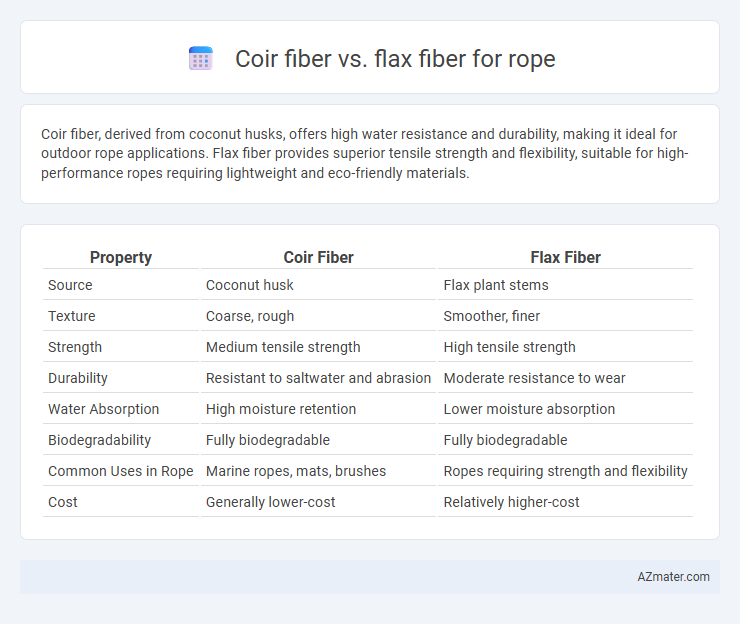Coir fiber, derived from coconut husks, offers high water resistance and durability, making it ideal for outdoor rope applications. Flax fiber provides superior tensile strength and flexibility, suitable for high-performance ropes requiring lightweight and eco-friendly materials.
Table of Comparison
| Property | Coir Fiber | Flax Fiber |
|---|---|---|
| Source | Coconut husk | Flax plant stems |
| Texture | Coarse, rough | Smoother, finer |
| Strength | Medium tensile strength | High tensile strength |
| Durability | Resistant to saltwater and abrasion | Moderate resistance to wear |
| Water Absorption | High moisture retention | Lower moisture absorption |
| Biodegradability | Fully biodegradable | Fully biodegradable |
| Common Uses in Rope | Marine ropes, mats, brushes | Ropes requiring strength and flexibility |
| Cost | Generally lower-cost | Relatively higher-cost |
Introduction to Natural Fibers in Rope Making
Coir fiber, derived from coconut husks, offers excellent durability and water resistance, making it ideal for marine ropes, while flax fiber provides superior tensile strength and flexibility suitable for fine ropes used in crafts and textiles. Natural fibers like coir and flax are biodegradable, sustainable alternatives to synthetic ropes, emphasizing eco-friendly applications. Understanding the distinct physical properties and uses of coir and flax fibers is essential for selecting the appropriate material in rope manufacturing.
Overview of Coir Fiber: Properties and Sources
Coir fiber, derived from the outer husk of coconut shells, is renowned for its high tensile strength, natural water resistance, and durability, making it ideal for rope manufacturing. This fiber is coarse, stiff, and resistant to saltwater, distinguishing it from flax fiber, which is smoother and more flexible but less resistant to moisture and abrasion. Predominantly sourced from tropical regions like India, Sri Lanka, and the Philippines, coir fiber offers sustainable and eco-friendly benefits due to its biodegradability and renewable nature.
Overview of Flax Fiber: Properties and Sources
Flax fiber, derived from the flax plant (Linum usitatissimum), is renowned for its high tensile strength, biodegradability, and resistance to moisture, making it an excellent choice for durable ropes. Sourced primarily from temperate regions in Europe and North America, flax fibers undergo retting and scutching processes to separate the long bast fibers used in rope manufacturing. The lightweight, smooth texture and resistance to environmental wear position flax fiber ropes as sustainable alternatives with superior load-bearing capabilities compared to coir fiber counterparts.
Mechanical Strength: Coir vs Flax Rope
Flax rope exhibits superior tensile strength and durability compared to coir fiber rope, making it more suitable for applications requiring higher mechanical load resistance. Coir fiber rope offers better resistance to abrasion and environmental degradation, but its tensile strength is significantly lower than flax, with flax fibers reaching tensile strengths of approximately 500-900 MPa compared to coir's 175-220 MPa. The mechanical strength advantages of flax rope make it preferred for heavy-duty uses, while coir remains cost-effective for lighter, moisture-exposed environments.
Durability and Longevity Comparison
Coir fiber, derived from coconut husks, is highly resistant to abrasion and water exposure, making it exceptionally durable for outdoor rope applications. Flax fiber, sourced from the flax plant, offers strong tensile strength and natural resistance to bacteria but tends to degrade faster under prolonged moisture and UV exposure. For longevity, coir ropes generally outperform flax fibers in harsh environmental conditions due to their natural resilience and slower decomposition rate.
Water Resistance and Weather Performance
Coir fiber exhibits superior water resistance compared to flax fiber due to its natural resilience against moisture absorption, making it ideal for marine and outdoor rope applications. Flax fiber, while stronger and more flexible, tends to degrade faster under prolonged exposure to water and adverse weather conditions. The high lignin content in coir enhances its durability and weather performance, ensuring longer lifespan in harsh environments.
Environmental Impact and Sustainability
Coir fiber, derived from coconut husks, is highly biodegradable and requires minimal chemical processing, making it a more sustainable option for rope production compared to flax fiber. Flax fiber cultivation demands significant water and pesticide use but offers higher tensile strength and durability, reducing the need for frequent replacement. Choosing coir fiber supports waste valorization and lower carbon emissions, while flax fiber emphasizes long-term usability and crop rotation benefits.
Flexibility and Handling Qualities
Coir fiber, derived from coconut husks, offers superior water resistance and rough texture, making it ideal for outdoor rope applications but less flexible and harder to handle compared to flax fiber. Flax fiber, sourced from the flax plant, exhibits excellent flexibility and smoothness, enhancing ease of knotting and overall handling, suitable for precise and delicate rope tasks. The choice between coir and flax fibers hinges on balancing durability and flexibility requirements tailored to specific rope uses.
Typical Applications: Coir vs Flax Ropes
Coir fiber ropes are widely used in marine and agricultural applications due to their high abrasion resistance and natural water repellency, making them ideal for mooring lines, cargo nets, and erosion control. Flax fiber ropes are preferred in decorative, craft, and light-duty industrial uses because of their smooth texture, biodegradability, and superior tensile strength compared to coir. Both fibers find their niche based on durability requirements and environmental conditions, with coir excelling in wet environments and flax favored for aesthetic and eco-friendly purposes.
Cost Analysis and Market Availability
Coir fiber, derived from coconut husks, is generally more cost-effective than flax fiber due to its abundant availability in tropical regions and lower processing expenses. Flax fiber, sourced from the flax plant, tends to have higher production costs influenced by labor-intensive extraction and limited growing areas, impacting its market price. Market availability favors coir fiber as it is widely produced in countries like India and Sri Lanka, whereas flax fiber supply is restricted primarily to European and North American regions.

Infographic: Coir fiber vs Flax fiber for Rope
 azmater.com
azmater.com